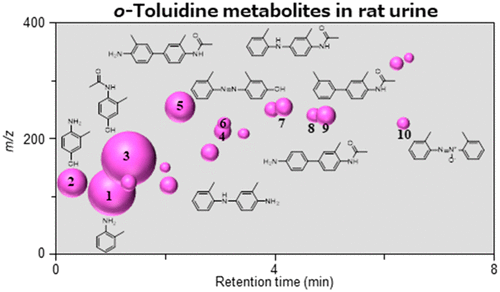当前位置:
X-MOL 学术
›
Chem. Res. Toxicol.
›
论文详情
Our official English website, www.x-mol.net, welcomes your
feedback! (Note: you will need to create a separate account there.)
Novel o-Toluidine Metabolite in Rat Urine Associated with Urinary Bladder Carcinogenesis.
Chemical Research in Toxicology ( IF 3.7 ) Pub Date : 2020-04-28 , DOI: 10.1021/acs.chemrestox.0c00098 Yuya Tajima 1 , Takeshi Toyoda 2 , Yuichiro Hirayama 1 , Kohei Matsushita 2 , Takanori Yamada 2 , Kumiko Ogawa 2 , Kenji Watanabe 1 , Takeji Takamura-Enya 3 , Yukari Totsuka 4 , Keiji Wakabayashi 1 , Noriyuki Miyoshi 1
Chemical Research in Toxicology ( IF 3.7 ) Pub Date : 2020-04-28 , DOI: 10.1021/acs.chemrestox.0c00098 Yuya Tajima 1 , Takeshi Toyoda 2 , Yuichiro Hirayama 1 , Kohei Matsushita 2 , Takanori Yamada 2 , Kumiko Ogawa 2 , Kenji Watanabe 1 , Takeji Takamura-Enya 3 , Yukari Totsuka 4 , Keiji Wakabayashi 1 , Noriyuki Miyoshi 1
Affiliation

|
o-Toluidine (o-Tol), a monocyclic aromatic amine, causes bladder cancer in humans and experimental animals and is therefore classified as a Group 1 carcinogen (IARC) in which the carcinogenicity of o-Tol is involved in metabolic activation, DNA damage, and DNA adduct formation. In the DNA adduct formation mechanism, o-Tol is metabolized by N-hydroxylation, N-acetoxylation, and then deacetoxylation to produce an electrophilic nitrenium ion, which is able to bind to a DNA base, such as dG-C8. Therefore, dG-C8-o-Tol is thought to be a plausible DNA adduct of o-Tol exposure. However, direct detection of dG-C8-o-Tol in biological samples has not been reported yet. Here, we show that a novel o-Tol metabolite, 2-methyl-N1-(2-methylphenyl)benzene-1,4-diamine (MMBD), a dimer by head-to-tail binding, was identified for the first time in o-Tol-exposed rat urine. MMBD was also detected in a reaction of o-Tol and S9 mix, indicating the formation was catalyzed by an enzymatic reaction. Moreover, MMBD showed a potent stronger mutagenicity in N-acetyltransferase overexpressed Salmonella typhimurium strains,and cytotoxicity in human bladder carcinoma T24 cells and human spleen lymphoblastoid TK6 cells compared with o-Tol. Furthermore, a DNA adduct (m/z 478.1) corresponding to dG-MMBD was detected in the reaction of calf thymus DNA with rat urine containing MMBD, and also in hepatic DNA of rats treated with o-Tol. These results therefore suggested that o-Tol-induced bladder carcinogenesis could be at least partly attributed to MMBD formation. The possible dimerization of monocyclic aromatic amines should be considered in the evaluation of the risk of bladder carcinogenesis after exposure.
中文翻译:

大鼠尿液中新型邻甲苯胺代谢产物与膀胱膀胱癌变相关。
ø甲苯胺(ø -Tol),单环芳族胺,使膀胱癌在人类和实验动物,因此被分类为第1族致癌物质(IARC),其中的致癌ø -Tol参与代谢活化,DNA损伤,以及DNA加合物的形成。在DNA加合物形成机理中,邻-Tol通过N-羟基化,N-乙酰氧基化然后脱乙酰氧基化进行代谢,以生成能够结合至DNA碱基(例如dG-C8)的亲电性氮离子。因此,认为dG-C8-邻-Tol是邻-Tol暴露的合理的DNA加合物。但是,直接检测dG-C8- o-尚未报道生物样品中的Tol。在这里,我们显示了一种新型的邻-Tol代谢产物2-甲基-N 1-(2-甲基苯基)苯-1,4-二胺(MMBD),通过头尾结合形成了二聚体,时间在邻苯酚暴露的大鼠尿液中。在邻-Tol和S9混合物的反应中也检测到MMBD ,表明该形成是通过酶促反应催化的。而且,与邻-Tol相比,MMBD在过表达N-乙酰基转移酶的鼠伤寒沙门氏菌菌株中具有更强的致突变性,对人膀胱癌T24细胞和人脾淋巴母细胞样TK6细胞具有细胞毒性。此外,DNA加合物(m/ z 478.1)在小牛胸腺DNA与含有MMBD的大鼠尿液以及经o -Tol处理的大鼠的肝DNA反应中检测到了与dG-MMBD相对应的值。因此,这些结果表明,邻-Tol诱导的膀胱癌发生可能至少部分归因于MMBD的形成。在评估暴露后膀胱癌发生的风险时,应考虑单环芳香胺可能的二聚。
更新日期:2020-04-28
中文翻译:

大鼠尿液中新型邻甲苯胺代谢产物与膀胱膀胱癌变相关。
ø甲苯胺(ø -Tol),单环芳族胺,使膀胱癌在人类和实验动物,因此被分类为第1族致癌物质(IARC),其中的致癌ø -Tol参与代谢活化,DNA损伤,以及DNA加合物的形成。在DNA加合物形成机理中,邻-Tol通过N-羟基化,N-乙酰氧基化然后脱乙酰氧基化进行代谢,以生成能够结合至DNA碱基(例如dG-C8)的亲电性氮离子。因此,认为dG-C8-邻-Tol是邻-Tol暴露的合理的DNA加合物。但是,直接检测dG-C8- o-尚未报道生物样品中的Tol。在这里,我们显示了一种新型的邻-Tol代谢产物2-甲基-N 1-(2-甲基苯基)苯-1,4-二胺(MMBD),通过头尾结合形成了二聚体,时间在邻苯酚暴露的大鼠尿液中。在邻-Tol和S9混合物的反应中也检测到MMBD ,表明该形成是通过酶促反应催化的。而且,与邻-Tol相比,MMBD在过表达N-乙酰基转移酶的鼠伤寒沙门氏菌菌株中具有更强的致突变性,对人膀胱癌T24细胞和人脾淋巴母细胞样TK6细胞具有细胞毒性。此外,DNA加合物(m/ z 478.1)在小牛胸腺DNA与含有MMBD的大鼠尿液以及经o -Tol处理的大鼠的肝DNA反应中检测到了与dG-MMBD相对应的值。因此,这些结果表明,邻-Tol诱导的膀胱癌发生可能至少部分归因于MMBD的形成。在评估暴露后膀胱癌发生的风险时,应考虑单环芳香胺可能的二聚。











































 京公网安备 11010802027423号
京公网安备 11010802027423号